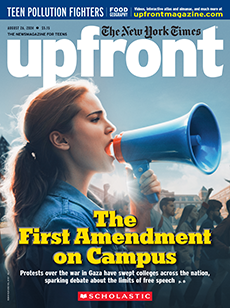Jules LeBlanc, of Los Angeles, was recently celebrating her 20th birthday in New York City. She documented much of her journey, from her sightseeing stops to a dinner out with family to all the packages that had piled up at her home in her absence. Later, she edited the clips into a 15-minute vlog—or video blog—and shared it on YouTube with her more than 4 million subscribers.
Recording and sharing footage of her daily activities like this is a regular undertaking for the social media creator.
“I just pull out my phone . . . and I start vlogging my day,” she says.
LeBlanc has made online content since she was a child, when her parents posted family videos on YouTube. Today she makes a living by sharing her own photos and videos with millions of fans on platforms such as YouTube, TikTok, and Instagram.
Jules LeBlanc, of Los Angeles, was recently celebrating her 20th birthday in New York City. She recorded much of her trip. She filmed her sightseeing stops, a dinner out with family, and all the packages that had piled up at her home in her absence. Later, she edited the clips into a 15-minute vlog, or video blog. She then shared it with her more than 4 million subscribers on YouTube.
Recording and sharing footage of her daily activities like this is a regular task for the social media creator.
“I just pull out my phone . . . and I start vlogging my day,” she says.
LeBlanc has made online content since she was a child. Her parents posted family videos on YouTube. Today she makes a living by sharing her own photos and videos with millions of fans on platforms such as YouTube, TikTok, and Instagram.
